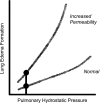Measurement of extravascular lung water using the single indicator method in patients: research and potential clinical value
- PMID: 19617309
- PMCID: PMC2770794
- DOI: 10.1152/ajplung.00127.2009
Measurement of extravascular lung water using the single indicator method in patients: research and potential clinical value
Abstract
Extravascular lung water includes all of the fluid within the lung but outside of the vasculature. Lung water increases as a result of increased hydrostatic vascular pressure or from an increase in lung endothelial and epithelial permeability or both. Experimentally, extravascular lung water has been measured gravimetrically. Clinically, the chest radiograph is used to determine whether extravascular lung water is present but is an insensitive instrument for determining the quantity of lung water. Bedside measurement of extravascular lung water in patients is now possible using a single indicator thermodilution method. This review critically evaluates the experimental and clinical evidence supporting the potential value of measuring extravascular lung water in patients using the single indicator method.
Figures













Similar articles
-
The clinical usefulness of extravascular lung water and pulmonary vascular permeability index to diagnose and characterize pulmonary edema: a prospective multicenter study on the quantitative differential diagnostic definition for acute lung injury/acute respiratory distress syndrome.Crit Care. 2012 Dec 11;16(6):R232. doi: 10.1186/cc11898. Crit Care. 2012. PMID: 23232188 Free PMC article.
-
Extravascular lung water and the pulmonary vascular permeability index may improve the definition of ARDS.Crit Care. 2013 Jan 24;17(1):108. doi: 10.1186/cc11918. Crit Care. 2013. PMID: 23347799 Free PMC article.
-
Assessing pulmonary permeability by transpulmonary thermodilution allows differentiation of hydrostatic pulmonary edema from ALI/ARDS.Intensive Care Med. 2007 Mar;33(3):448-53. doi: 10.1007/s00134-006-0498-6. Epub 2007 Jan 13. Intensive Care Med. 2007. PMID: 17221189
-
Transpulmonary dilution-derived extravascular lung water as a measure of lung edema.Curr Opin Crit Care. 2007 Jun;13(3):303-7. doi: 10.1097/MCC.0b013e32811d6ccd. Curr Opin Crit Care. 2007. PMID: 17468563 Review.
-
Extravascular lung water in ARDS patients.Minerva Anestesiol. 2013 Mar;79(3):274-84. Epub 2012 Dec 20. Minerva Anestesiol. 2013. PMID: 23254166 Review.
Cited by
-
Aortic volume determines global end-diastolic volume measured by transpulmonary thermodilution.Intensive Care Med Exp. 2020 Jan 2;8(1):1. doi: 10.1186/s40635-019-0284-8. Intensive Care Med Exp. 2020. PMID: 31897796 Free PMC article.
-
Transpulmonary thermodilution in patients treated with veno-venous extracorporeal membrane oxygenation.Ann Intensive Care. 2021 Jul 2;11(1):101. doi: 10.1186/s13613-021-00890-w. Ann Intensive Care. 2021. PMID: 34213674 Free PMC article.
-
Electrical impedance tomography (EIT) for quantification of pulmonary edema in acute lung injury.Crit Care. 2016 Jan 22;20:18. doi: 10.1186/s13054-015-1173-5. Crit Care. 2016. PMID: 26796635 Free PMC article.
-
Extravascular lung water in acute respiratory distress syndrome: potential clinical value, assumptions and limitations.Crit Care. 2012 Feb 27;16(1):114. doi: 10.1186/cc11187. Crit Care. 2012. PMID: 22369761 Free PMC article.
-
Clinical review: Respiratory monitoring in the ICU - a consensus of 16.Crit Care. 2012 Dec 12;16(2):219. doi: 10.1186/cc11146. Crit Care. 2012. PMID: 22546221 Free PMC article.
References
-
- Baudendistel LJ, Kaminski DL, Dahms TE. Evaluation of extravascular lung water by single thermal indicator. Crit Care Med 14: 52–56, 1986 - PubMed
-
- Beckett RC, Gray BA. Effect of atelectasis and embolization on extravascular thermal volume of the lung. J Appl Physiol 53: 1614–1619, 1982 - PubMed
-
- Bernard GR, Artigas A, Brigham KL, Carlet J, Falke K, Hudson L, Lamy M, Legall JR, Morris A, Spragg R. The American-European Consensus Conference on ARDS. Definitions, mechanisms, relevant outcomes, and clinical trial coordination. Am J Respir Crit Care Med 149: 818–824, 1994 - PubMed
Publication types
MeSH terms
Grants and funding
LinkOut - more resources
Full Text Sources

